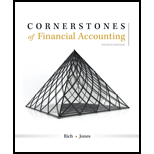
Concept introduction:
Bonds:
Bonds are debt instruments issued by the borrower company to its lenders. Bonds are issued at a specified rate of interest and for a specified time period. The bondholders get a fixed rate of interest on the bonds and repayment of the bonds at the maturity date.
Amortization of Bonds premium or discount:
Bonds may be issued at a premium or discount. The premium or discount on issue of binds is amortized or the life of bonds using the straight line or effective rate methods.
Requirement 1:
To prepare:
The Bond Amortization Table using
Concept introduction:
Bonds:
Bonds are debt instruments issued by the borrower company to its lenders. Bonds are issued at a specified rate of interest and for a specified time period. The bondholders get a fixed rate of interest on the bonds and repayment of the bonds at the maturity date.
Amortization of Bonds premium or discount:
Bonds may be issued at a premium or discount. The premium or discount on issue of binds is amortized or the life of bonds using the straight line or effective rate methods.
Requirement 2:
To prepare:
The
Concept introduction:
Bonds:
Bonds are debt instruments issued by the borrower company to its lenders. Bonds are issued at a specified rate of interest and for a specified time period. The bondholders get a fixed rate of interest on the bonds and repayment of the bonds at the maturity date.
Amortization of Bonds premium or discount:
Bonds may be issued at a premium or discount. The premium or discount on issue of binds is amortized or the life of bonds using the straight line or effective rate methods.
Requirement 3:
To indicate:
The presentation of bonds on the
Want to see the full answer?
Check out a sample textbook solution
Chapter 9 Solutions
Cornerstones of Financial Accounting - With CengageNow
- What is the cash paid for rent during 2022?arrow_forwardBefore prorating the manufacturing overhead costs at the end of 2016, the Cost of Goods Sold and Finished Goods Inventory had applied overhead costs of $59,700 and $54,000 in them, respectively. There was no Work-in-Process at the beginning or end of 2016. During the year, manufacturing overhead costs of $88,000 were actually incurred. The balance in the Applied Manufacturing Overhead was $94,500 at the end of 2016. If the under-or overapplied overhead is prorated between the Cost of Goods Sold and the inventory accounts, how much will be the Cost of Goods Sold after the proration? (rounded answer)arrow_forwardDexler Manufacturing has annual sales of $5.2 million, cost of goods sold of $2,000,000, average inventory of $1,200,000, and average accounts receivable of $800,000. Assume all of Dexler’s sales are on credit. What is the firm’s operating cycle? Right answerarrow_forward
 Cornerstones of Financial AccountingAccountingISBN:9781337690881Author:Jay Rich, Jeff JonesPublisher:Cengage Learning
Cornerstones of Financial AccountingAccountingISBN:9781337690881Author:Jay Rich, Jeff JonesPublisher:Cengage Learning Intermediate Accounting: Reporting And AnalysisAccountingISBN:9781337788281Author:James M. Wahlen, Jefferson P. Jones, Donald PagachPublisher:Cengage LearningPrinciples of Accounting Volume 1AccountingISBN:9781947172685Author:OpenStaxPublisher:OpenStax College
Intermediate Accounting: Reporting And AnalysisAccountingISBN:9781337788281Author:James M. Wahlen, Jefferson P. Jones, Donald PagachPublisher:Cengage LearningPrinciples of Accounting Volume 1AccountingISBN:9781947172685Author:OpenStaxPublisher:OpenStax College Financial Accounting: The Impact on Decision Make...AccountingISBN:9781305654174Author:Gary A. Porter, Curtis L. NortonPublisher:Cengage Learning
Financial Accounting: The Impact on Decision Make...AccountingISBN:9781305654174Author:Gary A. Porter, Curtis L. NortonPublisher:Cengage Learning EBK CONTEMPORARY FINANCIAL MANAGEMENTFinanceISBN:9781337514835Author:MOYERPublisher:CENGAGE LEARNING - CONSIGNMENT
EBK CONTEMPORARY FINANCIAL MANAGEMENTFinanceISBN:9781337514835Author:MOYERPublisher:CENGAGE LEARNING - CONSIGNMENT





